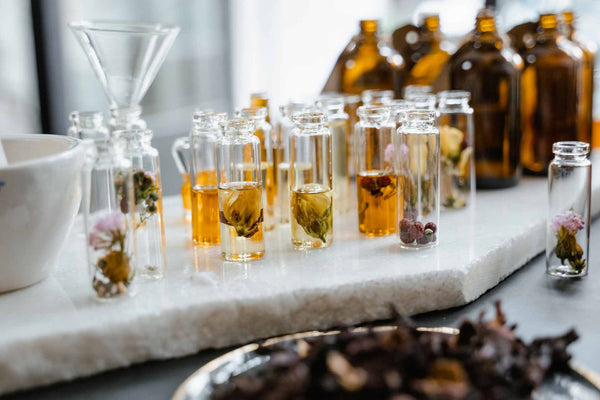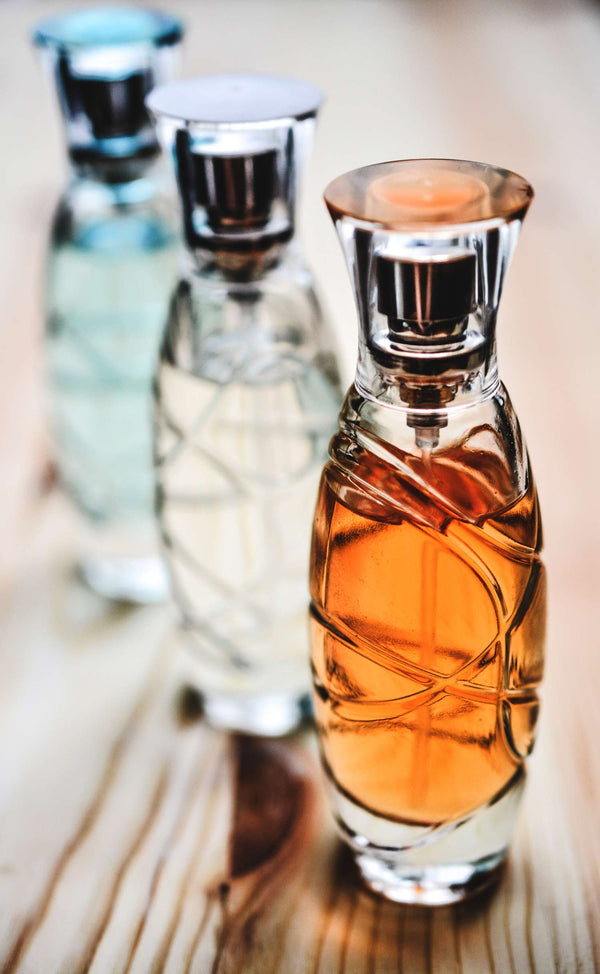
How To Clone Your Favorite Perfume or Cologne
Have you ever wanted to recreate your favorite perfume or cologne at home? To create a “dupe” as it were?
It is possible to replicate your favorite scent… with a caveat. Most popular fragrances contain a multitude of ingredients and notes, and are incredibly complicated. Getting an exact match is a lofty goal. But do not fear!
What you can do is create a scent inspired by your favorite fragrance.
How?
By focusing on the main notes.
In this article, we'll guide you through the process of creating a fragrance similar to your favorite perfume or cologne using Fragrantica, a comprehensive database of commercial and indie fragrances.
Steps to "Clone" Your Favorite Perfume or Cologne
We'll go into depth in the steps below, but the general process for cloning a perfume is:
- Find your Fragrance on Fragrantica
- Identify the Main Notes
- Gather Essential Oils and Perfume Ingredients
- Experiment with Blending
- Let Your Fragrance Mature
Step 1: Find Your Fragrance on Fragrantica
Begin by navigating to the Fragrantica website and searching for your chosen fragrance.
For this example, we'll use Vetiver Creed, a scent that showcases the exquisite vetiver essential oil, which is our store’s namesake.
(And as such, we sell the best vetiver we can find. This hydrodiffused vetiver is truly exceptional, surpassing other vetivers on the market, including synthetic versions.)

Step 2: Identify the Main Notes
Once you've found your fragrance's page on Fragrantica, look for the notes in two places. First, there might be a description of the notes near the top of the page.
For Vetiver Creed, it is:
Vetiver by Creed is a Woody Spicy fragrance for men. Vetiver was launched in 1948. The nose behind this fragrance is Henry Creed Fourth Generation. Top notes are Citruses and Bergamot; middle note is Ginger; base notes are Vetyver, Ambergris and Virginia Cedar.
Then, look for the perfume pyramid. The perfume pyramid is an image depiction of the main top, heart, and base notes in the fragrance, as voted on by users.

For Vetiver Creed, the main notes appear to be:
- Vetiver
- Citrus
- Bergamot
- Ginger
- Vetiver
- Ambergris
- Virginia cedar
As you can see, the pyramid will often be more detailed than the description.
Take note of these ingredients, and if necessary, research them.
Step 3: Gather the Essential Oils and Fragrance Ingredients
Now that you've identified the key notes in your favorite fragrance, it's time to acquire the necessary essential oils and ingredients.
Here is a basic list of what you’ll need to mix your perfume:
- Fragrance ingredients
- Carrier agent
- Perfume bottle for final fragrance
- Small vials for storing test blends
- Perfume tester strips (blotters)
- Labels for the vials
- Paper to track experiments
- Measurement tools (droppers and graduated cylinders for volume measurement, or a perfume scale for weight measurement)
If you can't find a specific fragrance note, consider substituting it with a similar scent from the same fragrance family. For instance, if you can't find Virginia cedar, you might opt for a different type of cedar essential oil.
We, of course, enthusiastically recommend our own online store for your fragrance ingredient needs.
All our fragrance notes are top quality and undiluted. If you’re familiar with perfume terminology, these are often marketed as fragrance accords or bases.
They are blends of synthetic and natural ingredients, like aroma chemicals, isolates, resins, and essential oils.
However, we don’t carry everything.
So, you may need to explore outside our store.
We recommend The Perfumer’s Apprentice fragrance for bases & blends, and Eden Botanicals for essential oils.
And don’t forget your fragrance carrier, as well as tools and supplies for mixing and storing your fragrance.
Having trouble deciding between an alcohol or oil-based perfume? Check out our article on the topic.
Step 4: Experiment with Blending
First, set up your workspace. Lay out the fragrances, your empty vials and other tools, and make sure you have labels and paper for taking notes.
Testing Perfume Scents Before Mixing
Before you start mixing, it's a good idea to familiarize yourself with the individual scents and how they interact with each other.
Place a drop of each fragrance on a separate perfume tester strip or blotter that you have written the fragrance name on.
Then, wave the strips under your nose, both individually and in combination, to get a sense of how the fragrances blend together.
This will give you a better understanding of each note's characteristics and how they complement or contrast with one another, and you may find that you already are making adjustments to the list of ingredients you will be using.
Now, you're ready to start mixing.
One method that works well is to mix your top, heart, and base notes separately, in distinct (and labeled!) vials.
A structure you could try is three top notes, three heart notes, and three base notes.
When blending your fragrance, you have two main options for measuring your ingredients: by weight or by volume. Each method has its strengths and weaknesses.
Measuring by Weight
Strengths:
- Measuring by weight is more accurate and precise than measuring by volume, as the density of essential oils can vary.
- It’s quicker and you don’t have to keep a mental count in your head of number of drops
- It allows for easier replication of your recipe, as you can record the exact weight of each ingredient used.
- It is the preferred method for professional perfumers and ensures consistent results.
Weaknesses:
- Requires a precise scale that can measure small quantities (ideally down to 0.01 grams).
- You don’t get to play with graduated cylinders
Measuring by Volume
Strengths:
- Requires no special equipment, as you can use a dropper or pipette to measure the oils.
- Or for larger quantities, you get to play with graduated cylinders
Weaknesses:
- Less accurate than measuring by weight due to variations in drop size and essential oil density.
- Harder to replicate recipes precisely, as drop sizes can differ between sessions and users.
Ultimately, the choice between measuring by weight or volume depends on your personal preference, the equipment you have available, and the level of precision you require.
If you're aiming for a more professional and accurate approach, measuring by weight is the recommended method.
However, if you're just starting or prefer a simpler, more intuitive approach, measuring by volume can still yield satisfactory results.
Tip: Throughout the mixing process, be sure to take detailed notes on the ratios and adjustments you make. This will help you refine your recipe and make it easier to replicate your fragrance in the future.
Begin by creating your base note blend. In a separate vial, combine the chosen base notes according to your desired ratios.
Start with small amounts, such as one drop or a small weight of each oil, and adjust as needed. Record the number of drops or weight used for each oil in your notebook.
Next, create your heart note blend in a new vial, following the same process as the base notes. Again, record the quantities used for each oil.
Finally, mix your top note blend in a third vial, keeping track of the amounts used.
Once you have your three blends, it's time to combine them to create your fragrance.
In a larger vial or bottle, add your base, heart, and top note blends, adjusting the ratios until you achieve a scent that closely resembles your target fragrance.
Start off your blending experiments by creating blends that are made up of the following ratio:
- 30-50% top notes
- 30-50% heart notes
- 20% base notes
Remember, perfumery is an art that requires patience and practice. Don't be discouraged if your first attempts don't quite match your expectations. Keep refining your blend, and let your nose guide you as you create your signature scent.
Once your blend is ready, it is time to add the carrier. How much depends on your end goal. Here are some common perfume and cologne dilutions:
Perfume & Cologne Dilutions
- Strongest Parfum: 16-20% fragrance/essential oil : 80-84% carrier agent
- Eau de Parfum: 11-15% fragrance/essential oil : 89-85% carrier agent
- Eau de Toilette: 10% fragrance/essential oil : 90% carrier agent
- Eau de Cologne: 6-9% fragrance/essential oil : 91-94% carrier agent
- Body Spray: 5% fragrance/essential oil : 95% carrier agent
Step 5: Let Your Fragrance Mature
Once you've created a blend you're happy with, allow your fragrance to mature. Store it in a cool, dark place for at least a week (ideally two weeks) to let the scents meld and develop.
After this period, reassess your fragrance and make any final adjustments to perfect your creation.
Congratulations, you have recreated your favorite fragrance!
Recreating your favorite perfume or cologne scent at home is a rewarding and engaging project.
By using Fragrantica to identify the main notes and experimenting with fragrances from our online store, you can create a personalized fragrance that captures the essence of your beloved scent.
Embrace the creative process, and enjoy the satisfaction of crafting your own signature fragrance.

